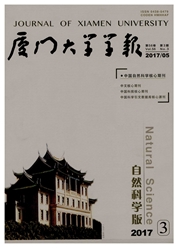

 中文摘要:
中文摘要:
多酚氧化酶(PPO)是蔬果酶促褐变的关键酶,抑制该酶活性是防止蔬果褐变的有效措施.在实验中发现NaHSO3对马铃薯PPO具有显著的抑制作用及在马铃薯切片护色中具有防褐变功能.实验结果表明:马铃薯PPO催化L-多巴形成的褐变物质在475nm波长处有特征性的吸收峰,并且该吸收峰随着NaHSO3浓度的增加明显降低.NaHSO3的抑制作用表现为不可逆效应,既可以延长酶促反应的迟滞时间,也降低了稳态的酶活力.当NaHSO3浓度增至0.12mmol/L时.酶促反应的迟滞时间从0延长至56s,稳态的酶活力下降了35.5%.在马铃薯切片保鲜实验中,对照组在第3天褐变指数达到2,第6天已经完全褐变,而50mmol/LNaHSO3处理的实验组在第6天褐变指数仅为0.6,有效遏制了马铃薯切片的酶促褐变,实验显示,NaHSO3通过抑制马铃薯PPO活力实现防褐变的效应.
 英文摘要:
英文摘要:
Polyphenoloxidase(PPO)is key enzyme of enzymatic browning during vegetables and fruits storage. It is an essential and effective way to inhibit the polyphenol oxidase activity in the fresh-keeping of vegetables and fruits. In this paper, the inhibitory effects on potato PPO and color-preservation effects on potato slice of sodium bisulfite have been studied. The results show that the J inhibition of sodium bisulfite on PPO is an irreversible reaction and that sodium bisulfite can result in prolonging the lag time of the enzyme reaction, and decreaseing the steady-state rate of the enzyme activity. When the concentration of sodium bisulfite reached to 0. 12 mmol/L, the enzyme activity lost about 35.5% and the lag time increased from 0 to 56 s. The potato slice of the control group was half browned after 3 days, and entirely browned after 6 days. While treated by 50 mmol/L of sodium bisulfite, the browning index of the test group was only 0.6, indicating that sodium bisulfite could stop the enzymatic browning of potato slice efficaciously by inhibiting the potato polyphenol oxidase activity.
 同期刊论文项目
同期刊论文项目
 同项目期刊论文
同项目期刊论文
 Inhibitory kinetics of p-substituted benzaldehydes on polyphenol oxidase from the Fifth instar of Pi
Inhibitory kinetics of p-substituted benzaldehydes on polyphenol oxidase from the Fifth instar of Pi Inhibitory effects of substrate analogs on enzyme activity and substrate specificities of mushroom t
Inhibitory effects of substrate analogs on enzyme activity and substrate specificities of mushroom t Inhibitory effects of 4-chlorosalicylic acid on mushroom tyrosinase and its antimicrobial activities
Inhibitory effects of 4-chlorosalicylic acid on mushroom tyrosinase and its antimicrobial activities Inhibitory effects of phloridzin dihydrate on the activity of mushroom (Agaricus bisporus) tyrosinas
Inhibitory effects of phloridzin dihydrate on the activity of mushroom (Agaricus bisporus) tyrosinas Inhibitory effects of methyl trans-cinnamate on mushroom tyrosinase and its antimicrobial activities
Inhibitory effects of methyl trans-cinnamate on mushroom tyrosinase and its antimicrobial activities Activation kinetics of cetylpyridinium chloride on the prophenol oxidase from pupae of blowfly (Sarc
Activation kinetics of cetylpyridinium chloride on the prophenol oxidase from pupae of blowfly (Sarc Inhibitory effects of cis- and trans- isomers of 3,5-dihydroxystilbene on the activity of mushroom t
Inhibitory effects of cis- and trans- isomers of 3,5-dihydroxystilbene on the activity of mushroom t 期刊信息
期刊信息
